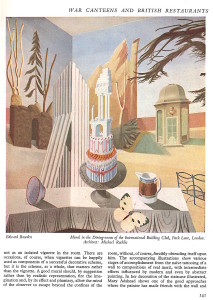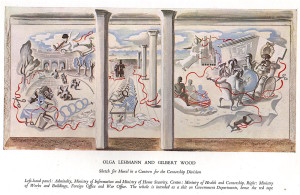 It is a sad fact that most of the best mural paintings executed in canteens, cafes and restaurants in the UK no longer exist. Unlike those executed for some public buildings, those in private premises are subject to the taste of those who take over the property. By far the most notorious example was, of course, the murals executed around 1913 on the walls of Rudolf Stulik’s Restaurant de la Tour Eiffel in Percy Street, just off Tottenham Court Road, by Wyndham Lewis, which were later painted over.
It is a sad fact that most of the best mural paintings executed in canteens, cafes and restaurants in the UK no longer exist. Unlike those executed for some public buildings, those in private premises are subject to the taste of those who take over the property. By far the most notorious example was, of course, the murals executed around 1913 on the walls of Rudolf Stulik’s Restaurant de la Tour Eiffel in Percy Street, just off Tottenham Court Road, by Wyndham Lewis, which were later painted over.
The prevalence of the post-war obsession of interior decorators with the ‘ white wall ‘ was a possible explanation for the disappearance of most the Second World War murals that feature in an article by the architect Oliver Hill in the November 1943 issue of The Studio magazine. Working within the tradition of thirteen centuries of mural painting in English churches, and using the contemporary iconography of posters, notably those of McKnight Kauffer, many of the muralists commissioned during the Second World War were asked to address what was essentially a captive audience –diners at many British restaurants, staff dining rooms and government canteens. Muralists saw these projects as an opportunity to introduce otherwise unappreciative diners to good public art. To the architect Hill, the mural was not the equivalent of a large framed representational painting that focussed the attention of the viewer on itself, but was part of the building on which it was painted. As such, rather than realistic representation, a ‘good mural ‘ should, according to Hill, ‘ fire the imagination and, by its effect and phantasy, allow the mind of the observer to escape beyond the confines of the room, without, of course, forcibly obtruding itself upon him ‘.
The government figure at the Ministry of Food in charge of this programme of mural making was Clive Gardiner, Principal of Goldsmith’s College. It was he to whom local authorities wishing to open a British Restaurant might apply; it was also his job to put the authorities in touch with local artists who had registered to take part in the scheme.
One of the artists who did register knew exactly what was required of a modern muralist. Mary Adshead, was a specialist in wall decoration. Her work on the staircase wall of the Service Men’s Club at Columba House, John Bright Street, Birmingham, shows a figure climbing a staircase in paint beside the real one, while in the background are painted landmarks of Birmingham, such as the city’s two cathedrals. This design demonstrated, in the view of Hill, that Adshead had ‘made friends with the wall’ by producing a work of art that could only have been created using the limitations offered. Alas, it seems that no trace of this mural has survived. Nor can any of Adshead’s other decorations for restaurants and canteens be traced. Luckily, this particular muralist is celebrated in the online site that admirers have established in her memory.
Fortunately, and against the trend, the large and lively murals produced by costume designer and portraitist Olga Lehmann, in partnership with Gilbert Wood, at a secret underground site at Corsham, Wiltshire, have survived, presumably because, as part of an official government property, there was no reason to remove them. Less fortunate were the brilliant murals, some of which ridiculed government ‘red tape ‘, (pictured) that the couple created for the dining room of the government’s censorship department in Holborn, which presumably was afterwards sold to a commercial outfit following the Allied victory. A similar fate seems to have befallen the murals executed in a canteen at Montpelier House, Tufnell Park, possibly after the property changed hands.
Another casualty was Edward Bawden’s characteristic mural (pictured) for the dining room of the International Building Club, Park Lane, London, which appears to have disappeared along with the building. The two sites in Leicester targeted by students of the city’s College of Arts and Crafts—the works canteen for the textile company Hart and Levy and the ‘British Restaurant’ in St Peter’s Street– also appear to have gone, both probably the victims of new decoration schemes.
It is sad fact that in the go-ahead fifties and swinging sixties the decorative styles of a wartime generation were less appreciated than those of, say, the Victorian and Georgian eras, which had achieved the status of ‘classics’. The appeal of the ‘ white wall ‘ played its part too—and this perhaps was regarded as a symbolic move away from the pain and loss that the Second World War had represented to so many who had been involved in it. [R.M.Healey]

Thank you for your very interesting piece. Could you please tell me where the article showing the Bawden Park Lane mural is taken from. The resolution isn’t high enough for me to see where the original came from and I would like to follow this up if possible, ideally knowing where it came from and the original date. I hope very much you can (easily) tell me?